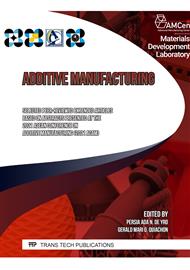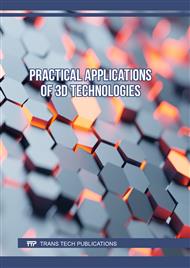[1]
M. Thiruchitrambalam, D. Bubesh Kumar, D. Shanmugam, and M. Jawaid, A review on PEEK composites – Manufacturing methods, properties and Applications,, Materials Today: Proceedings vol. 33, p.1085–1092, (2020).
DOI: 10.1016/j.matpr.2020.07.124
Google Scholar
[2]
D. Kumar, T. Rajmohan, and S. Venkatachalapathi, Wear Behavior of PEEK Matrix composites: A review,, Materials Today: Proceedings vol. 5, pp.14583-14589, (2018).
DOI: 10.1016/j.matpr.2018.03.049
Google Scholar
[3]
R . Wang, K.J. Cheng, R.C. Advincula, and Q. Chen, On the thermal processing and mechanical properties of 3D-printed polyether ether ketone,, MRS Communications, 2019,.
DOI: 10.1557/mrc.2019.86
Google Scholar
[4]
S. Singh et al, 3D printing of polyether-ether-ketone for biomedical applications,, European Polymer Journal 114 234-248, (2019).
DOI: 10.1016/j.eurpolymj.2019.02.035
Google Scholar
[5]
H. Spece, et al, 3D printed porous PEEK created via fused filament fabrication for osteoconductive orthopaedic surfaces,, Journal of the Mechanical Behavior of Biomedical Materials vol. 109, 103850, (2020).
DOI: 10.1016/j.jmbbm.2020.103850
Google Scholar
[6]
A. Le Duigou, G. Chabaud, R. Matsizaki and M. Castro, Tailoring the Mechanical properties of 3D-printed continuous flax/PLA biocomposites by controlling the slicing parameters,, Composites Part B, vol. 203, 108474, (2020).
DOI: 10.1016/j.compositesb.2020.108474
Google Scholar
[7]
P. Szymczyk-Ziolkowska, M.B. Labowska, J. Detyna, I. Michalak and P. Gruber, A Review of fabrication polymer scaffolds for biomedical applications using additive manufacturing techniques,, Biocybernetics and Biomedical Engineering 40 624-638, (2020).
DOI: 10.1016/j.bbe.2020.01.015
Google Scholar
[8]
M.M. Prabhakar, A. K. Saravanan, A.H. Lenin, I.J. Leno, K. Mayandi, and P.S. Ramalingam, A short review on 3D printing methods, process parameters and materials,, Materials Today: Proceedings vol. 45, pp.6108-6114, (2021).
DOI: 10.1016/j.matpr.2020.10.225
Google Scholar
[9]
B.S. Rupal, K.G. Mostafa, Y. Wang, A.J. Qureshi, A reverse CAD Approach for estimating Geometric and Mechanical Bahavior of FDM Printed Parts,, Precedia Manufacturing vol. 34 pp.535-544, (2019).
DOI: 10.1016/j.promfg.2019.06.217
Google Scholar
[10]
S. Sommacal, A. Matschinski, K. Drechsler, and P. Compston, Characterization of void and fiber distribution in 3D printed carbon-fiber/PEEK using X-ray Computed tomography,, Composites Part A. vol. 149, 106487, (2021).
DOI: 10.1016/j.compositesa.2021.106487
Google Scholar
[11]
M.R. Khosravani and T. Reinicke, Journal of Nondestructive Evaluation 39 75, (2020).
Google Scholar
[12]
A. Hernandez-Contreras et al (2020). Extended CT Void Analysis in FDM Additive Manufacturing Components. Materials, 13, 3831;.
DOI: 10.3390/ma13173831
Google Scholar
[13]
T. Jayaraghul et al, On the Use of X-ray Computed Tomography in Assessment of 3D-printed Components,, Materials Today: Proceedings vol. 44, pp.2963-2967, (2021).
Google Scholar
[14]
M. Rinaldi, et al, Additive layer manufacturing of poly (ether ether ketone) via FDM,, Composites Part B vol. 145, p.162–172, (2018).
DOI: 10.1016/j.compositesb.2018.03.029
Google Scholar
[15]
Y. Zhao et al. Mechanical characterization of biocompatible PEEK by FDM,. Journal of Manufacturing Processes 56: 28–42, (2020).
DOI: 10.1016/j.jmapro.2020.04.063
Google Scholar
[16]
Y. Wang et al. Mechanical properties of fused filament fabricated PEEK for biomedical applications depending on additive manufacturing parameters,. Journal of the mechanical behavior of biomedical materials 115:104250, (2021).
DOI: 10.1016/j.jmbbm.2020.104250
Google Scholar
[17]
P. Wang, et al (2019). Effects of printing parameters of fused deposition modeling on mechanical properties, surface quality, and microstructure of PEEK. Journal of Materials Processing Tech. 271: 62–74.
DOI: 10.1016/j.jmatprotec.2019.03.016
Google Scholar



